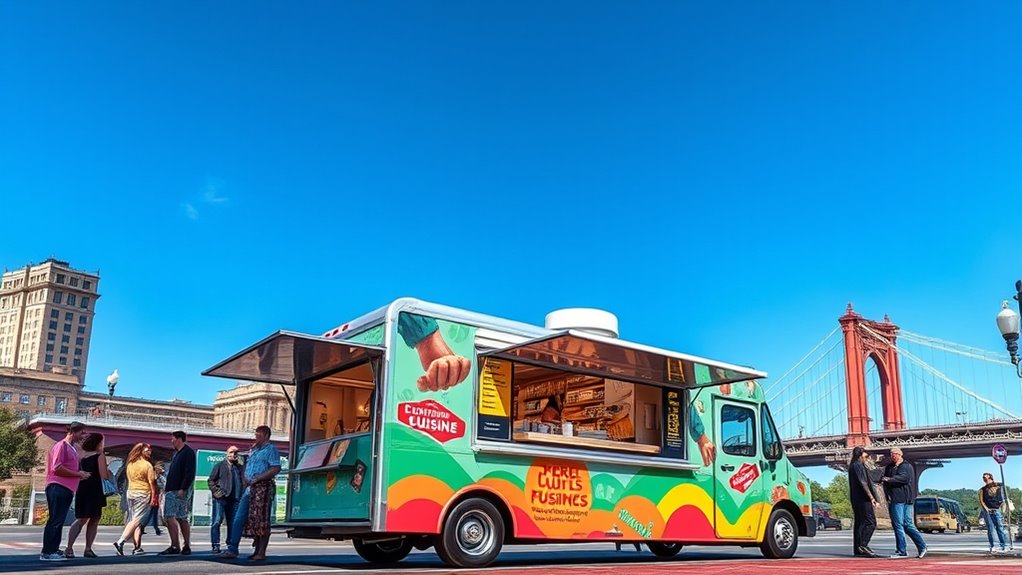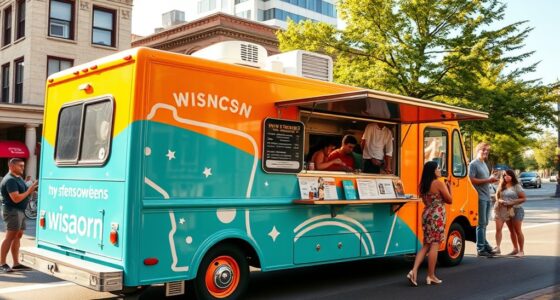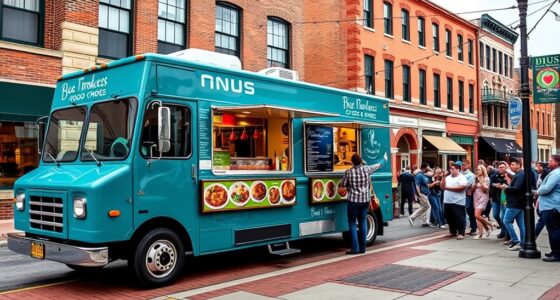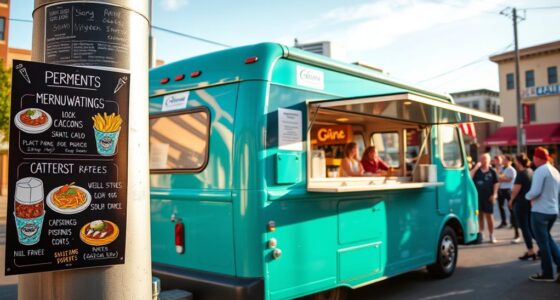To open a food truck in Cincinnati, you need a mobile food license, with fees ranging from $50 to $200 annually, and must pass health inspections. Budget around $20,000 to $150,000 for your truck and equipment. Choose busy locations like Fountain Square or near campuses to attract customers. Guarantee food safety standards and develop a simple, appealing menu to stand out. Keep exploring for detailed steps to start your food truck successfully.
Key Takeaways
- Obtain a mobile food license from Cincinnati health district, complete inspections, and pay permit fees ranging from $50 to $200 annually.
- Budget between $20,000 and $150,000 for new or used food trucks, plus equipment, inventory, permits, and technology costs.
- Target high-traffic locations like Fountain Square, Findlay Market, parks, university campuses, and event venues for maximum visibility.
- Ensure compliance with Ohio health regulations through unannounced inspections, proper food safety plans, and staff certifications.
- Develop a focused menu with simple, popular items, leverage local ingredients, and implement marketing strategies to attract and retain customers.
Navigating Permit and Licensing Procedures in Cincinnati
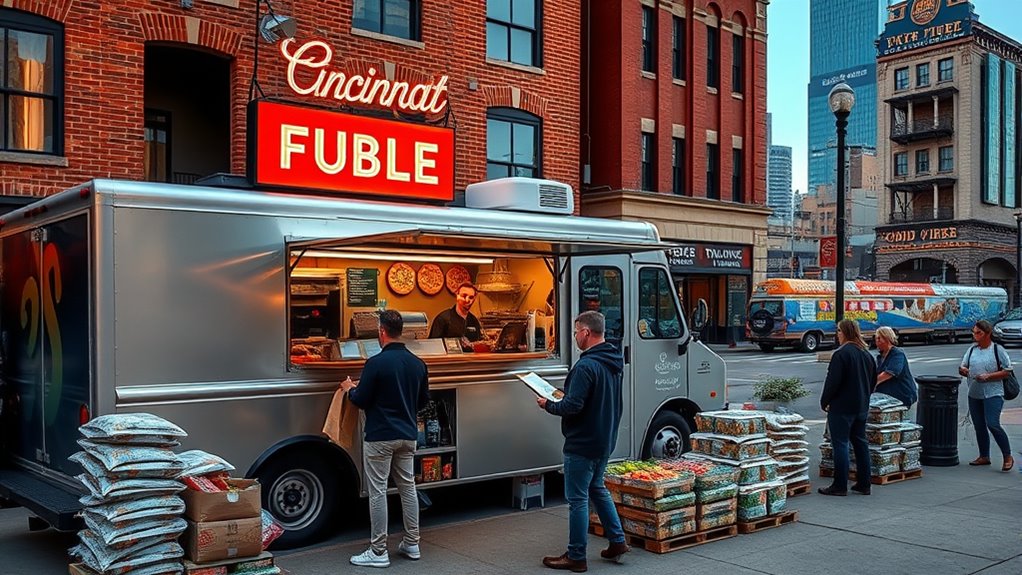
Managing permit and licensing procedures in Cincinnati can seem complex, but understanding the process makes it manageable. You’ll need a mobile food license if you operate a food truck, cart, or mobile unit. The application is submitted to the local health district based on your business address or first Ohio location if out-of-state. Regular inspections ensure your food safety practices and vehicle meet standards. You and your staff must hold mandatory food safety certifications. Permit fees typically range from $50 to $200 annually. You’re also required to document use of an approved commissary or commercial kitchen for food prep and vehicle maintenance. Additionally, your food truck must comply with vehicle standards, and you may need to submit a plumbing plan with a fee of around $150. Fire safety and insurance certificates are also essential for legal compliance. Utilizing advanced fraud detection techniques can help protect your business from financial risks associated with processing payments.
Estimating Startup Expenses for Your Food Truck Venture

Estimating startup expenses for your food truck venture involves carefully accounting for vehicle costs, equipment, initial inventory, permits, insurance, and technology. New trucks in Ohio cost between $50,000 and $150,000, while used options range from $20,000 to $80,000. Essential equipment like grills, fryers, and ovens can add up to $7,000 or more. Refrigeration, prep tables, and safety gear such as fire suppression systems also require significant investment. Initial inventory typically costs $2,000 to $5,000, plus packaging and serveware expenses around $1,300 to $3,000. Permit and license fees, including health and parking permits, average $1,800 to $2,000. Technology, like POS systems, can cost $1,000 to $3,000 upfront, with monthly software fees. Budget accordingly for insurance and unexpected costs. Understanding legal and insurance requirements is essential to ensure compliance and protect your investment throughout your business journey. Additionally, researching vehicle maintenance and durability is important for long-term operational success.
Identifying Prime Locations to Maximize Customer Reach
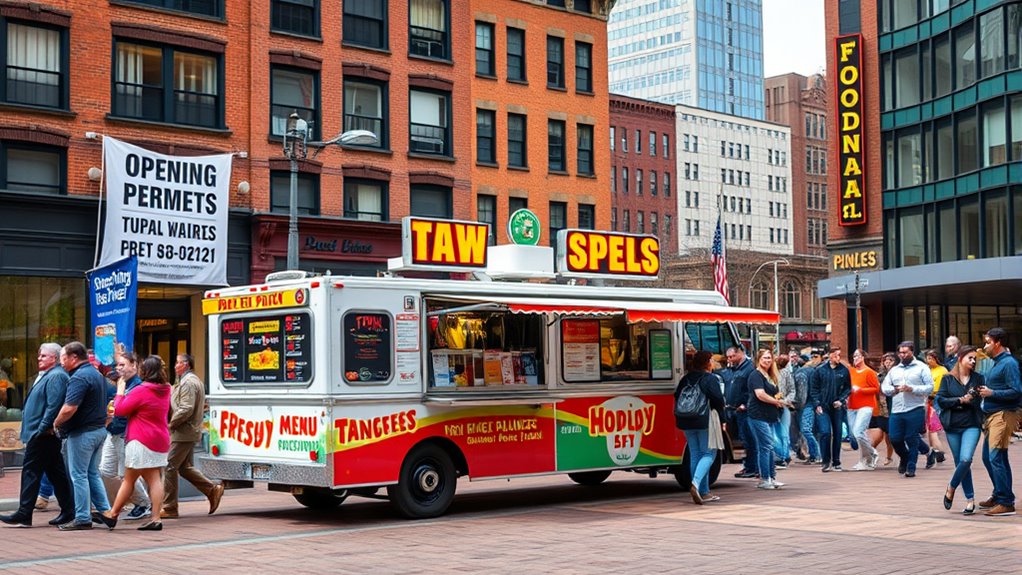
Choosing the right locations is essential for maximizing your food truck’s customer reach and sales. High-traffic public spaces like Fountain Square and Findlay Market attract large crowds during peak hours and weekends, making them excellent spots for steady sales. Parks and riverfront areas draw families and event-goers, especially in warmer months, offering seasonal opportunities. Busy downtown districts benefit from lunch rushes, ideal for quick, portable meals, while university campuses generate consistent student traffic during school sessions. Event hotspots such as festivals, music events, and sporting venues create concentrated sales opportunities during specific times. Residential neighborhoods with growing food scenes, like Walnut Hills and Oakley, are perfect for evening and weekend crowds. Locations near transit hubs, bike trails, and breweries also enhance visibility and accessibility, boosting your customer base. Additionally, understanding the local culture and heritage, such as cowboy history in Fort Worth or mountain scenery around Pigeon Forge, can help tailor your menu and marketing strategies to attract more customers.
Ensuring Food Safety and Meeting Health Inspection Standards
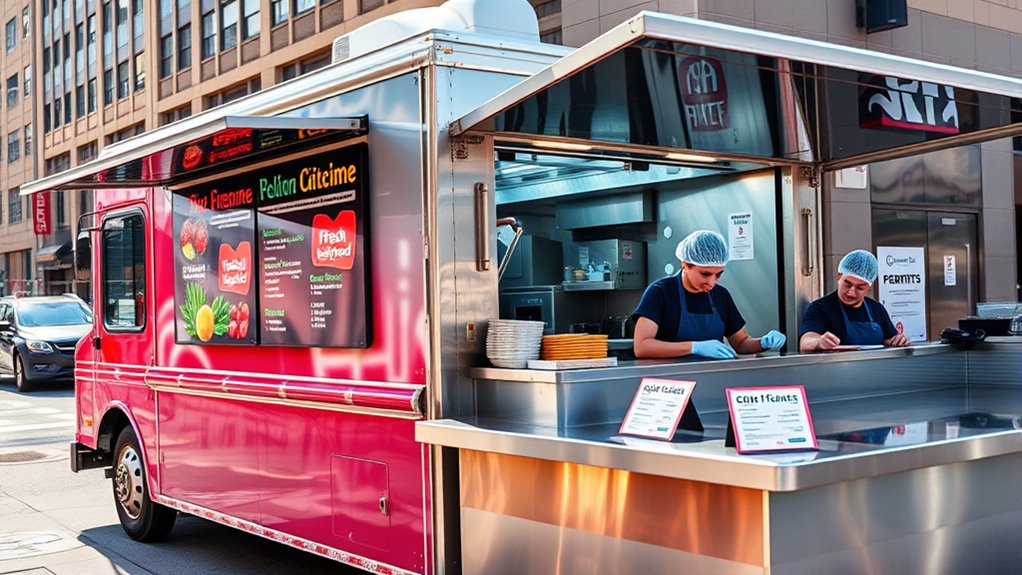
Making certain of food safety and meeting health inspection standards is essential for your food truck’s legal operation and customer trust. You must pass a thorough local health inspection at least once per licensing period before receiving your license. Temporary licenses are available for five days but don’t permit full operation at the same location. You’ll need to submit plans detailing equipment, surfaces, lighting, and menu for review. During inspections, your truck must display your business name and origin clearly. Inspections occur unannounced 1-2 times annually, checking for compliance with Ohio’s Food Safety Code. Your designated Person in Charge (PIC) must oversee safety practices and ensure ongoing staff training. Equipment, handwashing stations, and sanitation procedures must meet strict standards to avoid violations and ensure safe food handling. Electric power sources, such as bike generators, can be used to support sustainable operations if properly maintained and inspected.
Crafting a Menu and Developing Your Food Truck Business Strategy
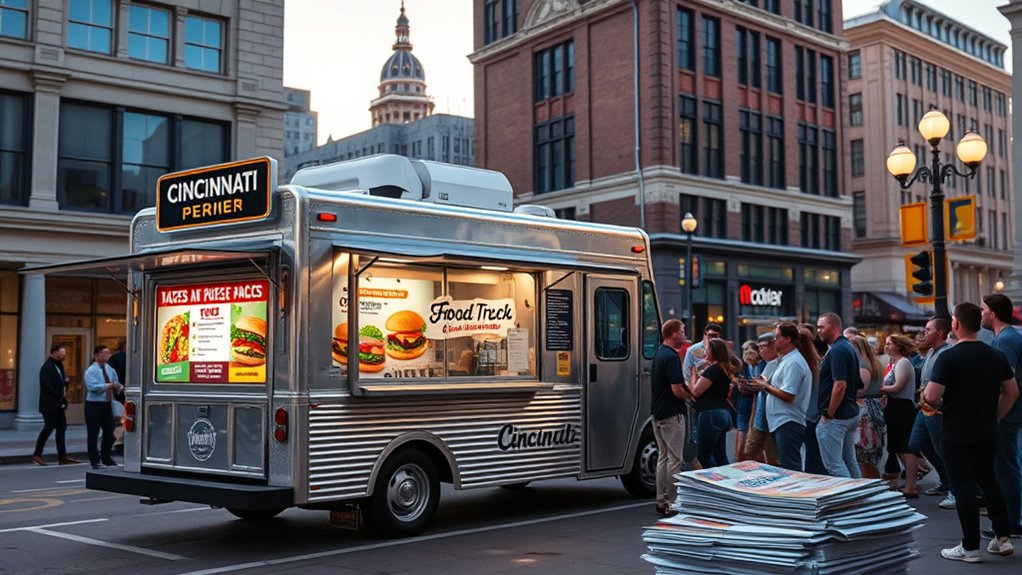
Developing a well-defined menu and a solid business strategy lays the foundation for your food truck’s success. Start by identifying your concept and target market—knowing who you’re serving and what they want helps shape your menu, pricing, and location choices. Keep your menu simple, focusing on a few standout dishes that are quick to prepare and easy to serve, sharing ingredients to cut costs and improve efficiency. Design a clear, visually appealing menu with straightforward descriptions, highlighting best sellers and unique offerings. Incorporate seasonal and local ingredients to add freshness and relevance. Price your items to balance affordability and profit, leveraging low-cost, high-margin options like tacos. Regularly refine your menu based on customer feedback and food trends to stay competitive and engaging. Understanding current industry trends and consumer preferences can also help you adapt your offerings and marketing strategies for sustained success. Additionally, considering health-conscious options can attract a broader customer base seeking nutritious choices.
Frequently Asked Questions
How Long Does It Typically Take to Obtain All Necessary Permits in Cincinnati?
You’ll usually need at least 10 business days to get all your permits in Cincinnati. Start your application early, submit all required documents, and pay fees promptly to avoid delays. The process includes plan reviews, inspections, and possibly additional steps if you operate a mobile food truck. Keep in mind, delays can happen if applications are incomplete or inspections don’t pass on the first try, so plan accordingly.
Are There Specific Cincinnati Neighborhoods With Restrictions on Food Truck Operations?
Imagine you’re steering Cincinnati’s neighborhood maze like a modern-day explorer. Some neighborhoods, especially residential areas, have strict restrictions on food truck operations—like prohibiting parking during certain hours or near homes. Commercial districts may limit parking duration or require special permits. Always check local zoning laws before setting up, because operating in restricted areas can lead to fines or shutdowns. Staying informed helps you avoid trouble and keep your food truck rolling smoothly.
What Are Common Mistakes to Avoid During the Licensing Process?
When steering the licensing process, you should avoid incomplete or inaccurate applications, which delay approval. Don’t overlook required documentation like proof of identity, vehicle registration, and insurance. Schedule all necessary health and safety inspections and follow local codes strictly. Budget adequately for permits and fees, and don’t start operating before receiving approval. Stay on top of renewals and notify authorities about any changes to remain compliant and prevent fines or shutdowns.
Can I Operate a Food Truck Without a Commissary Kitchen in Cincinnati?
You can’t operate a food truck in Cincinnati without a commissary kitchen. The health department requires all mobile vendors to have an approved facility for food prep, storage, and cleaning. Skipping this step risks license denial and fines. To stay compliant, find a licensed commissary that offers the necessary services like storage, water, and waste disposal. Using a proper commissary guarantees you meet health standards and operate legally.
How Often Are Health and Fire Inspections Required After Initial Licensing?
You might think once you’re licensed, the inspections are a rare event, but nope, Cincinnati keeps you on your toes. Health and fire inspections happen at least once per licensing period, with extra visits if things look suspicious or if you change equipment. So, even after getting licensed, you’ll face ongoing checks—like a surprise party you didn’t know was coming—ensuring your truck stays compliant year-round.
Conclusion
Starting a food truck in Cincinnati might seem overwhelming at first, but with proper planning, you’ll navigate permits, costs, and locations smoothly. Don’t let concerns about initial expenses hold you back; many successful food truck owners started small and scaled up. Focus on creating a standout menu and building a strong marketing plan. With dedication and a clear strategy, you’ll turn your food truck dream into a thriving Cincinnati business.
